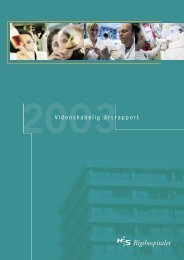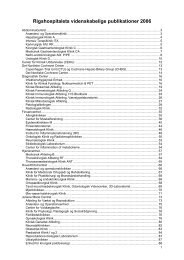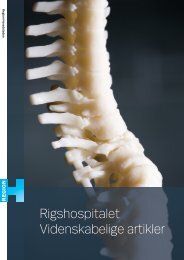View - CTU
View - CTU
View - CTU
You also want an ePaper? Increase the reach of your titles
YUMPU automatically turns print PDFs into web optimized ePapers that Google loves.
ast one year after<br />
he primary outcome<br />
lity without apical<br />
response to thermal<br />
Jnosed if the apical<br />
as in other parts of<br />
rvers independently<br />
vas defined as the<br />
1 pretreatment pain<br />
'come measure was<br />
:ig. 6, bottom), the<br />
ency.<br />
Results (Study Ill)<br />
Excavation trial<br />
314 patients were randomized. The stepwise excavation group had a significantly<br />
higher success rate (74.1%) at 1-year follow-up (median 476.5 days) compared with<br />
the direct complete excavation group (62.4%) (P = 0.044). The pulp was exposed in<br />
25 teeth (17.5%) after stepwise excavation and in 43 teeth (28.9%) after direct<br />
complete excavation (Table 2).<br />
Rundomizi..-2.4) 11.7ro.5:1".5) 0.044<br />
43 (18.9) -11 A (-21.3: -l.2) 0.030<br />
1 (l.3) II.I 1-:\.5: 3-81 0.665<br />
4 (2.7i -l.3 {-5.:5: 181 0.711<br />
7 (4.7) 0.9 (-··U: 6.Xl 0.934<br />
~ria (11 =49)<br />
+5i<br />
i a; i.mot!wr clinic 32)<br />
Table 2. Outcome measure analysis of teeth at follow-up (Source: Table 2, Study Ill. Reprinted with<br />
permission from European Journal of Oral Sciences, Wiley-Blackwell, Oxford).<br />
•hloj (n "'SJ<br />
out randamiza1ia1?) (n "~ 5)<br />
Prognostic factors<br />
Patients with pretreatment pain were significantly less likely to show a successful<br />
treatment result at follow-up compared to those without pain, when adjusting for the<br />
effect of treatment, age, and centre. Treatment of patients younger than 50 years<br />
(median for the group: 28 years) was more likely to result in sustained pulp vitality<br />
without apical radiolucency than following treatment of older patients (median age of<br />
the group: 58 years); however, only borderline significance was noted. The odds<br />
ratios of pulp exposure differed among the centres, with centres 1 and 2 significantly<br />
more often avoiding pulp exposure (adjusted for the effect of treatment, age and<br />
pain).<br />
llocation, follow-up and<br />
printed with permission<br />
19








